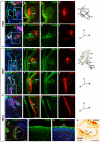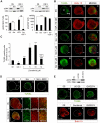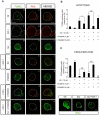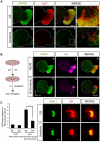RAF kinase activity regulates neuroepithelial cell proliferation and neuronal progenitor cell differentiation during early inner ear development
- PMID: 21203386
- PMCID: PMC3010996
- DOI: 10.1371/journal.pone.0014435
RAF kinase activity regulates neuroepithelial cell proliferation and neuronal progenitor cell differentiation during early inner ear development
Abstract
Background: Early inner ear development requires the strict regulation of cell proliferation, survival, migration and differentiation, coordinated by the concerted action of extrinsic and intrinsic factors. Deregulation of these processes is associated with embryonic malformations and deafness. We have shown that insulin-like growth factor I (IGF-I) plays a key role in embryonic and postnatal otic development by triggering the activation of intracellular lipid and protein kinases. RAF kinases are serine/threonine kinases that regulate the highly conserved RAS-RAF-MEK-ERK signaling cascade involved in transducing the signals from extracellular growth factors to the nucleus. However, the regulation of RAF kinase activity by growth factors during development is complex and still not fully understood.
Methodology/principal findings: By using a combination of qRT-PCR, Western blotting, immunohistochemistry and in situ hybridization, we show that C-RAF and B-RAF are expressed during the early development of the chicken inner ear in specific spatiotemporal patterns. Moreover, later in development B-RAF expression is associated to hair cells in the sensory patches. Experiments in ex vivo cultures of otic vesicle explants demonstrate that the influence of IGF-I on proliferation but not survival depends on RAF kinase activating the MEK-ERK phosphorylation cascade. With the specific RAF inhibitor Sorafenib, we show that blocking RAF activity in organotypic cultures increases apoptosis and diminishes the rate of cell proliferation in the otic epithelia, as well as severely impairing neurogenesis of the acoustic-vestibular ganglion (AVG) and neuron maturation.
Conclusions/significance: We conclude that RAF kinase activity is essential to establish the balance between cell proliferation and death in neuroepithelial otic precursors, and for otic neuron differentiation and axonal growth at the AVG.
Conflict of interest statement
Figures







Similar articles
-
AKT signaling mediates IGF-I survival actions on otic neural progenitors.PLoS One. 2012;7(1):e30790. doi: 10.1371/journal.pone.0030790. Epub 2012 Jan 23. PLoS One. 2012. PMID: 22292041 Free PMC article.
-
Cyclic AMP/PKA-dependent paradoxical activation of Raf/MEK/ERK signaling in polycystin-2 defective mice treated with sorafenib.Hepatology. 2012 Dec;56(6):2363-74. doi: 10.1002/hep.25872. Epub 2012 Aug 27. Hepatology. 2012. Retraction in: Hepatology. 2023 Sep 1;78(3):E64. doi: 10.1097/HEP.0000000000000485. PMID: 22653837 Free PMC article. Retracted.
-
Strict regulation of c-Raf kinase levels is required for early organogenesis of the vertebrate inner ear.Oncogene. 1999 Jan 14;18(2):429-37. doi: 10.1038/sj.onc.1202312. Oncogene. 1999. PMID: 9927199
-
Targeting Raf-kinase: molecular rationales and translational issues.Ann Oncol. 2006 Jun;17 Suppl 7:vii124-7. doi: 10.1093/annonc/mdl964. Ann Oncol. 2006. PMID: 16760274 Review.
-
Trophic effects of insulin-like growth factor-I (IGF-I) in the inner ear.Hear Res. 2004 Oct;196(1-2):19-25. doi: 10.1016/j.heares.2003.12.022. Hear Res. 2004. PMID: 15464297 Review.
Cited by
-
Disrupting the interaction between retinoblastoma protein and Raf-1 leads to defects in progenitor cell proliferation and survival during early inner ear development.PLoS One. 2013 Dec 31;8(12):e83726. doi: 10.1371/journal.pone.0083726. eCollection 2013. PLoS One. 2013. PMID: 24391814 Free PMC article.
-
Insulin receptor substrate 2 (IRS2)-deficient mice show sensorineural hearing loss that is delayed by concomitant protein tyrosine phosphatase 1B (PTP1B) loss of function.Mol Med. 2012 Mar 30;18(1):260-9. doi: 10.2119/molmed.2011.00328. Mol Med. 2012. PMID: 22160220 Free PMC article.
-
Early otic development depends on autophagy for apoptotic cell clearance and neural differentiation.Cell Death Dis. 2012 Oct 4;3(10):e394. doi: 10.1038/cddis.2012.132. Cell Death Dis. 2012. PMID: 23034329 Free PMC article.
-
Application of insulin-like growth factor-1 in the treatment of inner ear disorders.Front Pharmacol. 2014 Sep 10;5:208. doi: 10.3389/fphar.2014.00208. eCollection 2014. Front Pharmacol. 2014. PMID: 25309440 Free PMC article. Review.
-
Otic Neurogenesis Is Regulated by TGFβ in a Senescence-Independent Manner.Front Cell Neurosci. 2020 Aug 17;14:217. doi: 10.3389/fncel.2020.00217. eCollection 2020. Front Cell Neurosci. 2020. PMID: 32973450 Free PMC article.
References
-
- Kelley MW. Regulation of cell fate in the sensory epithelia of the inner ear. Nat Rev Neurosci. 2006;7:837–849. - PubMed
-
- Rubel EW, Fritzsch B. Auditory system development: primary auditory neurons and their targets. Annu Rev Neurosci. 2002;25:51–101. - PubMed
-
- León Y, Sánchez-Galiano S, Gorospe I. Programmed cell death in the development of the vertebrate inner ear. Apoptosis. 2004;9:255–264. - PubMed
-
- Sanchez-Calderon H, Milo M, Leon Y, Varela-Nieto I. A network of growth and transcription factors controls neuronal differentation and survival in the developing ear. Int J Dev Biol. 2007;51:557–570. - PubMed
-
- Davies D. Temporal and spatial regulation of alpha6 integrin expression during the development of the cochlear-vestibular ganglion. J Comp Neurol. 2007;502:673–682. - PubMed
Publication types
MeSH terms
Substances
LinkOut - more resources
Full Text Sources
Medical
Molecular Biology Databases
Research Materials
Miscellaneous

